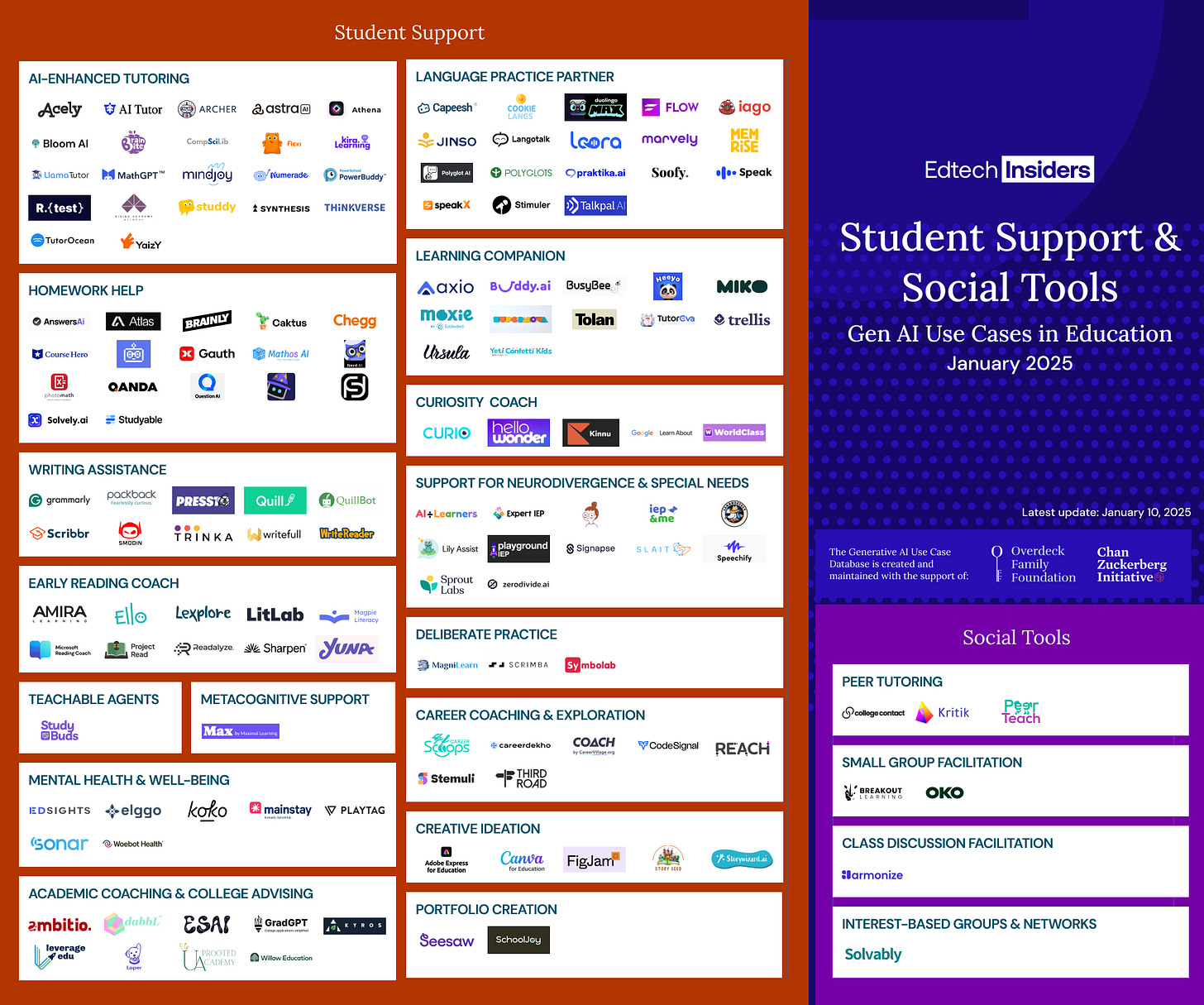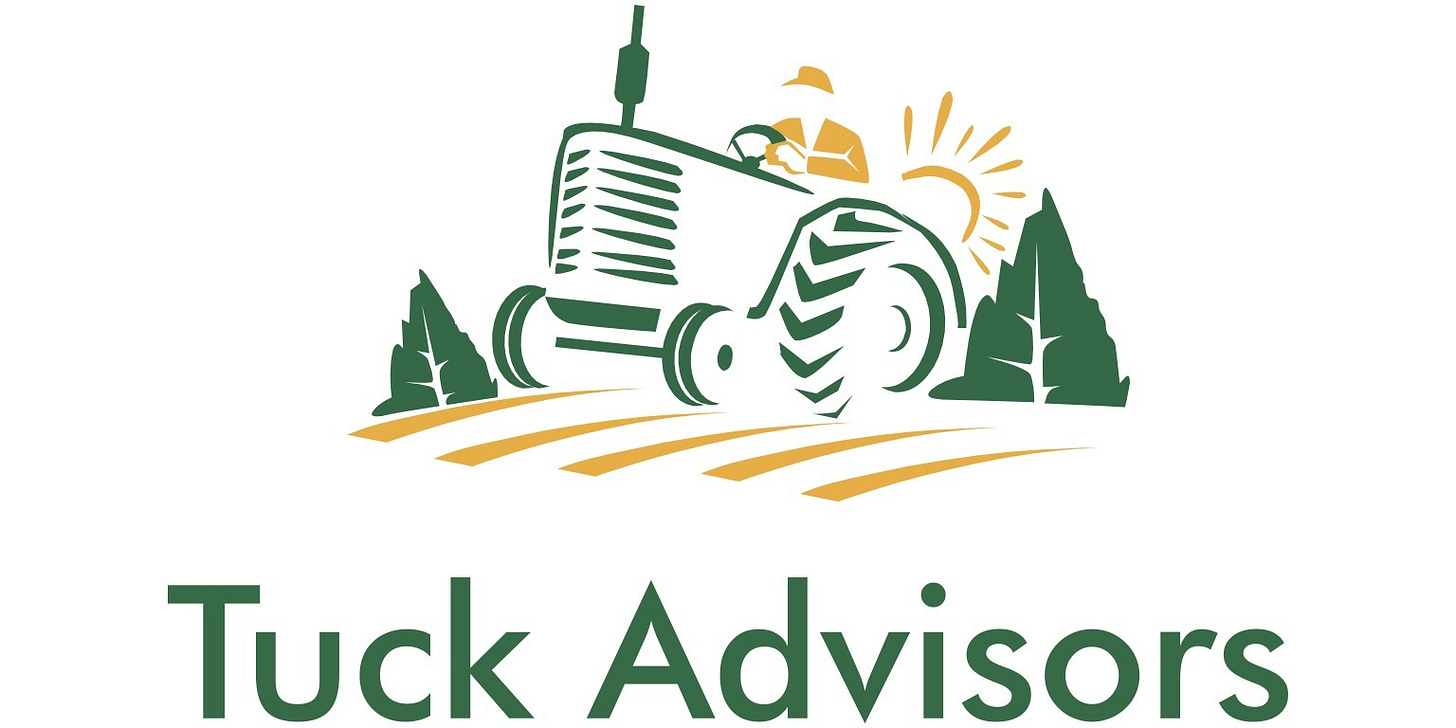Support for Every Learner: Transforming Student Support with Generative AI
Top trends and insights from The Edtech Insiders Generative AI Map research process on how Generative AI is transforming Student Support and Social Tools
Support for Every Learner: Transforming Student Support with Generative AI
By Alex Sarlin
As part of our updates to the Edtech Insiders Generative AI Map, we’re excited to release a new mini market map and article deep dive on Generative AI tools that are specifically designed for Student Support and Social Tools use cases.
For those who have concentrated primarily on AI edtech vendors that serve institutional markets like schools and districts, the remarkable scale of tools in the Student Support and Social Tools use case categories may come as a revelation. Many of the tools in these categories are sold directly to students and families in K-12 or higher education, and are intended to be used outside of formal classroom settings.
In our database, the Student Support use case category encompasses tools that:
Provide thorough and instant feedback
Target linguistic aptitude
Expand access to specialized support
Motivate students
Specialize in pedagogical models
And, our Social Tools use case category includes tools that:
Boost collaboration
Support effective discussion
Facilitate peer to peer learning
Gen AI Trends for Student Support and Social Tools
AI-powered student support tools raise valid concerns when they cross the line into “let AI do your homework” or “use AI to avoid plagiarism detection.” Understandably, educators worry that offloading too much thinking onto these tools erodes genuine learning in favor of convenience and grades. However, the same technology can also deliver powerful benefits.
For instance, AI-enhanced tutoring platforms can generate endless practice problems with real-time feedback, a pivotal approach to building mastery. Well-designed AI tutors can also incorporate proven learning strategies like elaborative interrogation, WISE feedback, customized retrieval practice, deliberate practice, and more! Guided by cognitive load theory and growth mindset principles, these systems can craft highly effective, individualized learning experiences that adapt to each student.
The real “killer feature” of AI for student support lies in personalization. By recalling a student’s unique interests and past performance, AI tools foster deeper engagement and ongoing relationships. Though true, full-scale personalization remains an emerging reality, many tools are moving in this direction.
By weaving together these innovations, educators can balance academic integrity with a richer, more student-centered approach to learning. When used thoughtfully, AI has the potential to elevate the quality of instruction, bolster student engagement, and ultimately enrich education in ways we are only beginning to imagine.
While we can’t encapsulate everything that is included in the rapidly evolving landscape of Student Support and Social Tools, here are some of the top trends and insights we noticed while completing our most up to date research for The Edtech Insiders Gen AI Map:
Creating AI-Powered Support Teams
AI has the potential to fill many roles in a student’s life: teacher, tutor, learning specialist, study partner, counselor (guidance, career, college, academic, or mental health), or facilitator for collaboration. This ability to create an AI “support team” could be transformative for underserved students facing teacher shortages or losing tutoring funds.
Taking a step back even further, nearly all U.S. students contend with a lack of specialists or high student-to-specialist ratios, not only those who are underserved or facing budget cuts. More than half of school districts and 80% of states reported shortages of special education teachers last year. Although the American School Counselors Association (ASCA) and the National Association of College Admission Counseling (NACAC) recommend a maximum 250:1 student-to-counselor ratio, only two states currently meet that benchmark.
Shifting from Transactional to Personal
We’re shifting from quick-fix homework helpers and Q&A bots to ongoing learning partnerships, where AI systems remember student histories, interests, and preferences while building long-term relationships. Already, AI tutors, learning companions, and language practice partners strive to form persistent, personalized connections—an approach that’s even more vital for counseling AIs, which must recall a student’s career interests or learning challenges over time.
The key question remains: how well, and how soon, can AI replicate the professional expertise of these important roles? Which aspects will humans always perform better, and which rely so heavily on human relationships that AI simply cannot simulate them effectively? Finally, do the risks of AI malpractice in high-stakes areas like mental health or college admissions outweigh the benefits of improved access and scalability?
Evolving Multimodal Interfaces
A key emerging trend is the rise and continued growth of “multimodality” in student interactions. For example, preliterate learners using reading coaches can’t interact with text prompts, and language practice partners thrive on natural conversation. Consequently, voice and video interactions are becoming more common, leveraging advancing capabilities in both frontier and open-source models. As costs drop, we can expect rapid integration of video avatars, gestural interfaces, and live demonstrations into tutoring and counseling, along with multiple input/output modes for accessibility—especially real-time voice chat and two-way video.
Balancing Engagement and Effectiveness
One of edtech’s recurring challenges is that while good consumer technology is comfortable, effective educational technology—technology that truly pushes learners outside their comfort zone—is not. In practice, direct-to-consumer homework helper apps have quickly found product-market fit by addressing an urgent pain point (efficient homework completion) and spreading virally through peer networks. As of this writing, three such apps—Gauth by ByteDance, Question.ai, and Photomath (Google)—rank among the top 10 education apps in the Apple App Store, competing with established names like Duolingo, Canvas, and Remind/ParentSquare. These tools succeed precisely because they make education “easier,” yet real learning often requires productive struggle.
There is a critical need for school-integrated systems that can match consumer apps’ engagement levels while complying with institutional requirements like integration, privacy, and visibility. Student-friendly improvements to institutional technology could help bridge the gap between “comfortable” consumer tech and truly effective education. More engaging formats, natural interfaces, and persistent relationships might encourage deeper learning—without merely outsourcing students’ thinking or math homework to AI.
Social Tools are Coming… Maybe?
We found surprisingly few explicitly “social” tools—those designed to foster class or small-group discussions or connect peers for tutoring or interest-based groups. Yet there’s a widespread desire to avoid a future where students learn in isolation with AI bots. Creating these social tools may be the next major frontier, which could involve allowing AI to listen in on or record student discussions for small-group facilitation, or even letting an AI teaching assistant co-lead class discussions via a classroom speaker. Much remains to be discovered about how to implement and develop these solutions, along with navigating the social realities of integrating technology into in-person learning.
What’s Next: Highly Customized Learning
In the future, AI tutors, learning companions, and language practice partners are likely to advance quickly, becoming video-based and competing on “charisma” as much as on pedagogical prowess. Increasingly, students treat academic content as a starting point rather than an endpoint—remixing slides, readings, or practice sets into preferred formats. This shift could spark new, student-driven learning styles that may seem counterintuitive to traditional educators.
Google NotebookLM’s audio overviews, which turn learning materials into podcasts, are just the beginning. We’re already seeing efforts to align content with students’ existing consumption habits—think TikTok-style quick clips, YouTube influencers, or celebrity tie-ins. Eventually, we may witness students transforming academic material into binge-worthy video series, games rivaling commercial titles, or immersive simulations that enable real-world (or fantastical) practice.
Edtech Insiders is Sponsored By:
Calling All Education Entrepreneurs! The Milken-Penn GSE Education Business Plan Competition (EBPC) is accepting applications now through February 19, 2025. Compete for over $200,000 in cash and prizes and connect with global education leaders and investors. Since 2010, the competition has awarded $2 million, with winners and finalists securing over $200 million in funding.
The EBPC is the world’s premier competition for early-stage ventures tackling inequities in education through innovation. It's open to education ventures worldwide addressing learning at any level, with less than $2M raised or earned in the past year—no Penn affiliation required!
This edition of the Edtech Insiders Newsletter is sponsored by Tuck Advisors.
Since 2017, Tuck Advisors has been a trusted name in Education M&A. Run by serial entrepreneurs with over 25 years of experience in founding, investing in, and selling companies, we believe you deserve M&A advisors who work as hard as you do. Please enjoy access to The M&A Matrix by Tuck Advisors™ on ChatGPT—tailored to support founders and CEOs like you in navigating the M&A world.
Have questions, or are you ready to explore the next steps? Reach out to us.
Cooley LLP is the go-to law firm for edtech innovators, from early childhood through workforce. Informed by decades of experience in the education vertical, Cooley created the first edtech practice to provide industry-informed, business-minded counsel to companies and organizations at all stages of the corporate lifecycle. Cooley provides a multidisciplinary approach to client needs, offering seamless collaboration across offices and practices.
To learn more about what Cooley can do for you, reach out to Naomi May.






